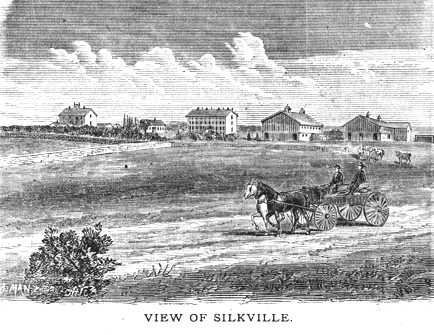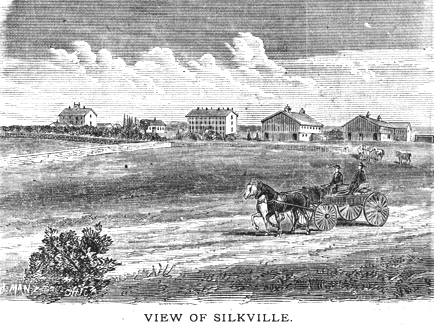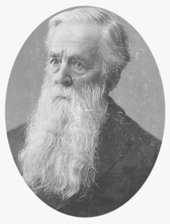 It would be more appropriate to call today’s ghost town a “ghost commune”, established by Ernest Valeton de Boissère in 1869. He was a wealthy Frenchman, born into a Bordeaux aristocratic family in 1810. When Napoleon III came into power after the Third French Revolution, de Boissère departed France in 1852 for political reasons and immigrated to America.
It would be more appropriate to call today’s ghost town a “ghost commune”, established by Ernest Valeton de Boissère in 1869. He was a wealthy Frenchman, born into a Bordeaux aristocratic family in 1810. When Napoleon III came into power after the Third French Revolution, de Boissère departed France in 1852 for political reasons and immigrated to America.

 Did you enjoy this article snippet? Yes? Check out Digging History Magazine. This article has been updated significantly with new research and published in the July-August 2019 issue of the magazine. The magazine is on sale in the Digging History Magazine store and features these stories (100+ pages of stories, no ads):
Did you enjoy this article snippet? Yes? Check out Digging History Magazine. This article has been updated significantly with new research and published in the July-August 2019 issue of the magazine. The magazine is on sale in the Digging History Magazine store and features these stories (100+ pages of stories, no ads):
- “Drought-Locusts-Earthquakes-B-Blizzards (Oh My!)” – Perhaps no state is possessive of a more appropriate motto than Kansas: Ad Astra per Aspera (“To the stars through difficulties”, or more loosely translated “a rough road leads to the stars”1). By the time the state adopted its motto in 1876, fifteen years post-statehood, it had experienced not only a brutal, bloody beginning (“Bloody Kansas”) but had endured (and continued to struggle with) extreme pestilence, preceded by severe drought and even an earthquake in April 1867. In the early days being Kansan was not for the faint of heart.
- “Home Sweet Soddie” – For years The Great Plains had been a vast expanse to be endured on the way to California and Oregon. Now the United States government was making 270 million acres available for settlement – practically free if, after five years, all criteria had been met. The criteria, referred to as “proving up” meant improvements must be made (and proof provided) by cultivating the land and building a home. For many their first home would be a dugout, a sod-covered hole in the ground.
- “Wholesale Murder at Newton” – It’s called “The Gunfight at Hyde Park” or the “Newton Massacre”. One newspaper headlined it as “Wholesale Murder at Newton”, another called it an “affray” and another a “riot”. Whatever, it was bloody, and one of the biggest gunfights in the history of the Wild West, more deadly than the legendary gunfight at the OK Corral.
- “Kansas Ghost Towns” – It might be more appropriate to call this Kansas ghost town, established by Ernest Valeton de Boissière in 1869, a “ghost commune” (Silkville). Nicodemus. There was something genuinely African in the very name. White folks would have called their place by one of the romantic names which stud the map of the United States, Smithville, Centreville, Jonesborough; but these colored people wanted something high-sounding and biblical, and so hit on Nicodemus.
- “The Land of Odds: Kwirky Kansas” – For some of us the mention of Kansas invokes memories of one of the classic films of our childhood, The Wizard of Oz. With a tongue-in-cheek reference this article highlights some of the state’s history and people in a series of vignettes – some serious, some not so serious (the real “oddballs”) in a light-hearted fashion. A rollicking fun article covering a range of Kansas “oddities” and “oddballs”, including one of the most dangerous quacks to have ever practiced medicine, Dr. John R. Brinkley.
- “Mining Kansas Genealogical Gold” – One of my favorite “adventures in research” is to discover obscure genealogical records or perhaps stumble across a set of records at Ancesty.com or Fold3 which turns out to be a gold mine of information. This article highlights some real gems available at Ancestry.
- “Chautauqua: The Poor Man’s Educational Opportunity” – During an era spanning the mid-1870s through the early twentieth century, Kansans, like many Americans across the country, anticipated the summer season known as Chautauqua, an event Theodore Roosevelt called “the most American thing in America”. By 1906 when Roosevelt made such an astute observation the movement had evolved into a non-sectarian gathering, where “all human faiths in God are respected. The brotherhood of man recreating and seeking the truth in the broad sunlight of love, social co-operation.”
- And more, including book reviews and tips for finding elusive genealogical records.
Since January 2018 new articles are published in a digital magazine (PDF) available by individual issue purchase or subscription (with three options). Most issues run between 70-85 pages, filled with articles of interest to history-lovers and genealogists — it’s all history, right? 🙂 No ads — just carefully-researched, well-written stories, complete with footnotes and sources.
Want to know more or try out a free issue? You can download either (or both) of the January-February 2019 and March-April 2019 issues here: https://digging-history.com/free-samples/
Thanks for stopping by!

